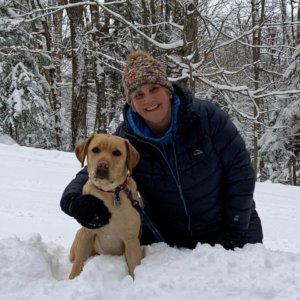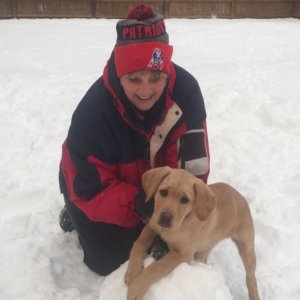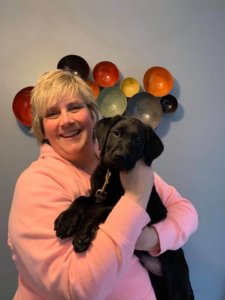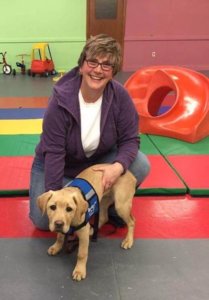Main Menu
About the author: Jake Smith is a senior in high school from West Lafayette, IN. He enjoys playing football, running track, and spending time with his friends. He plans to pursue a career in business and foreign language after attending Purdue University. Jake wrote this profile in conjunction with Kari Parrish as an assignment in a senior composition class taught by Kathy Nimmer, a Guiding Eyes graduate who is partnered with Nacho, a yellow lab guide dog.

Kari Parrish is a fifth-grade teacher from South Glens Falls, New York. Being three hours away from New York City, South Glens Falls is fairly rural, but there are plenty of things to do there. She enjoys hiking, camping, animals, taking trips to New York City, and assisting at her local animal shelter. Kari has been raising puppies on and off for Guiding Eyes for the Blind for twenty-two years. The reputation of Guiding Eyes is well known, and they have been in operation since 1954, according to guidingeyes.org. Kari was made aware of Guiding Eyes for the Blind from a coworker, who was involved with the organization. Raising these puppies involves substantial physical and emotional commitment. After raising her first puppy, Lucky, the proud feeling of seeing their puppy become a guide and benefit the lives of others gave Kari a feeling of satisfaction. These puppies are not only serious workers, but they are also like any other pet. They enjoy playing ball, swimming, and being around other dogs. Although these dogs are very playful and fun, once the Guiding Eyes harness comes out, they are aware that it is time to work. They love being a guide just as much as they enjoy playing. Kari also received influence from her mother, who was very giving with her time and love. Kari’s mother instilled these same traits in her. Finally, Kari enjoys a challenge, and this challenge is overcoming the sadness and fear of giving up the puppy she had raised and loved for over a year that became part of her family. The combination of the feeling of satisfaction of seeing her puppy succeed, influence from her mother (giving her time and love to these puppies), and the challenges of overcoming the sadness and fear of “saying goodbye” to the puppies they have raised caused Kari to initially start raising puppies, and also to continue raising puppies to this day.

As previously stated, raising puppies requires a substantial commitment. As time-consuming as puppy raising may be, the emotional toll is more prevalent. Guiding Eyes for the Blind pairs people with guide dogs. Kari obviously helps raise these dogs and will inevitably give up the puppy she raised. This is incredibly difficult. Kari has had a deep love for animals all her life and develops a bond with the pups she raises. She becomes immersed with the puppy she is raising, as the pup becomes a part of her daily life. For example, Kari brings puppies into her classroom to socialize. Not only is this an engaging part of the day for young students, but it also helps her students feel as though they are playing a role in this act of volunteerism. Not only is she raising them to eventually be a guide dog, but they are also a temporary pet. The fact that this pup will guide another life, and prevent them from danger daily makes Kari proud and fills her with a feeling of satisfaction seeing her puppy graduate. Knowing that the puppy she helped raise directly affects the life of another is motivating and is a core reason why Kari continues to raise puppies. Kari has stated that she struggles to say goodbye to the puppy she raised, and rightfully so. In this situation, the pros outweigh the cons, and she knows that most of these puppies were not meant to be pets, but a guiding, loving companion.

The influence from her mother also led her to raise puppies, though this is a cause she did not initially think about until she started reflecting on her experiences through this process as a puppy raiser. Kari says, ”My mother was a very giving person of her time and love.” This statement is important because the amount of time and love required to raise these puppies and then give them up is astronomical. The raisers follow a strict agenda. This challenge would put most people in a state of high emotion, though Kari embraces it. As previously stated, these dogs take a hefty time commitment that differs from just raising a house pet. As a guide dog, they have to be ready for any situation or environment that they may encounter. Kari has to implement these situations during the early stages of the dog’s life so that they are familiar with them by the time they are paired with their “forever person”. This can include things like taking them to restaurants, stores, or integrating them into various social environments. It is important that the dog doesn’t feel overwhelmed or nervous when in a certain situation. The puppy also learns to settle, lay down, and relax when he or she is around a stimulating environment. If so, this could lead to being hazardous to the person they are guiding. These environments also include things that people with sight think are trivial. Even a scintilla of change in the terrain could be enough for the visually impaired to be dangerous.
Not only does it include changes in social environments and terrain, but it also includes everyday encounters. Walking down the sidewalk and going downstairs are both examples of this, and this is also something sighted people would not often think about. This is an everyday challenge for the blind, and their guide dogs must be ready for any possible situation. Kari also stated that these dogs are ultimately bred to be guide dogs. On occasion, the dogs do not graduate from their guide training. For these dogs, puppy raisers, including Kari, like to say that “the pup chooses a different career.” The puppy essentially chooses what is best for them, and where they feel the most content and comfortable. Other job opportunities include bomb-sniffing or other service dog programs. In Kari’s experience, the dog she is currently raising (her name is Yetta) is most content when she is learning new skills or walking. Another point that takes up a considerable amount of time is walking. Kari said that in order to engage her dog into certain environments, she walks the pup in quiet towns, busy streets, onto buses, elevators, and even ballparks. The pup must learn to enjoy watching exciting experiences rather than engaging in them. This can be very difficult for a pup who loves to play and adores others. In turn, this engages the pup in an environment that a blind person may be in as well. This prepares them for the real world atmosphere when they are eventually paired.
 Eventually, the raiser must say goodbye to the puppy he or she has raised. This is the most difficult part of their time together. Though raising these dogs does fill Kari with a sense of pride, and she says,” I am doing something worthy with the free time in my life.” Kari wants to make sure the dog she raises is never scared, hesitant, or nervous when the pup goes back to Guiding Eyes for formal training to not only become a guide but eventually be paired with her forever person. Ultimately, she is loyal to the dog and the dog’s happiness. She wants the puppy she raised to be comfortable in their career. She also said, even if the dogs do not graduate from guide school, then they can still be a loving, caring companion. Since these dogs are so intelligent, they can be excellent house pets. For example, one of the dogs she raised (Vonny) eventually became a part of her family. Vonny had “bad house manners, was afraid of random things like sneezing, cheering people while watching sports on TV, thunder (all things that guide dogs cannot fear), so he didn’t make it as a guide,” Kari stated. Vonny was their lovable dog until his passing, which was about a decade ago. No matter what each pup eventually ends up doing with the remainder of his or her life, all Kari wants is for the dog she raised to be happy and safe as well.
Eventually, the raiser must say goodbye to the puppy he or she has raised. This is the most difficult part of their time together. Though raising these dogs does fill Kari with a sense of pride, and she says,” I am doing something worthy with the free time in my life.” Kari wants to make sure the dog she raises is never scared, hesitant, or nervous when the pup goes back to Guiding Eyes for formal training to not only become a guide but eventually be paired with her forever person. Ultimately, she is loyal to the dog and the dog’s happiness. She wants the puppy she raised to be comfortable in their career. She also said, even if the dogs do not graduate from guide school, then they can still be a loving, caring companion. Since these dogs are so intelligent, they can be excellent house pets. For example, one of the dogs she raised (Vonny) eventually became a part of her family. Vonny had “bad house manners, was afraid of random things like sneezing, cheering people while watching sports on TV, thunder (all things that guide dogs cannot fear), so he didn’t make it as a guide,” Kari stated. Vonny was their lovable dog until his passing, which was about a decade ago. No matter what each pup eventually ends up doing with the remainder of his or her life, all Kari wants is for the dog she raised to be happy and safe as well.
Kari has dedicated her time and love to the puppies she has raised over the last twenty-two years. Raising these pups takes a loving person who genuinely cares about not only the person who needs guidance from the dog they have raised but for the dog itself. There were many reasons Kari became a puppy raiser, but the main ones were the satisfactory feeling of providing a benefit to another life through the pup she raised, influence from her mother (giving her time and love to these puppies), and the challenges of overcoming the sadness and fear of “saying goodbye” to the puppies they have raised caused Kari to initially start raising puppies, and also continue raising puppies to this day. Though parting with these pups is difficult, the motivation of helping others through the love and care of these pups makes all the effort worth it.